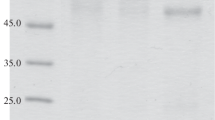Summary
-
1.
Acetylcholinesterase (AChE) was purified 20,000-fold in a 43% yield from 90 g of human cerebellum by combined immunoaffinity and ligand affinity chromatography. The purified enzyme migrated as a 68,000-dalton band during polyacrylamide gel electrophoresis under denaturing and reducing conditions.
-
2.
Balb/c mice were immunized with multiple 10-µg injections of this material in order to raise monoclonal antibodies to human brain AChE. Three such antibodies were obtained and characterized.
-
3.
Each antibody cross-reacted distinctively with AChEs from other mammals. No antibody recognized human plasma butyrylcholinesterase but all reacted with AChE from human red blood cells.
-
4.
Antibodies HR5 and HR3 performed well in two-site immunoassays for AChE. With these assays we compared autopsy samples of cortical region A9 from six controls (nonneurological cases) and five patients with Alzheimer's disease. The latter showed a highly significant 60% deficit of AChE protein.
-
5.
The present antibodies will permit additional immunochemical studies of cholinergic systems in dementia.
Similar content being viewed by others
References
Atack, J. R., Perry, E. K., Bonham, J. R., Perry, R. H., Tomlinson, B. E., Blessed, G., and Fairbairn, A. (1983). Molecular forms of acetylcholinesterase in senile dementia of Alzheimer type: Selective loss of the intermediate (10S) form.Neurosci. Lett. 40199–204.
Atack, J. R., Perry, E. K., Perry, R. H., Wilson, I. D., Bober, M. J., Blessed, G., and Tomlinson, B. E. (1985). Blood acetyl- and butyrylcholinesterases in senile dementia of Alzheimer type.J. Neurol. Sci. 701–12.
Bird, E. D., and Iversen, L. L. (1974). Huntington's chorea: Post-mortem measurement of glutamic acid decarboxylase, choline acetyltransferase and dopamine in basal ganglia.Brain 97457–472.
Brimijoin, S., and Hammond, P. (1988). Measuring trace cholinesterases in brain and blood by 2-site immunoassay (submitted for publication).
Brimijoin, S., Mintz, K. P., and Alley, M. (1983). Production and characterization of separate monoclonal antibodies to human acetylcholinesterase and butyrylcholinesterase.Mol. Pharmacol. 24513–520.
Brimijoin, S., Hammond, P., and Rakonczay, Z. (1987). Two-site immunoassay for acetylcholinesterase in brain, nerve and muscle.J. Neurochem. 49555–562.
Ellman, G. L., Courtney, K. D., Andres, V. Jr., and Featherstone, R. M. (1961). A new rapid colorimetric determination of acetylcholinesterase activity.Biochem. Pharmacol. 788–95.
Fazekas de St. Groth, S., and Scheidegger, D. (1980). Production of monoclonal antibodies: Strategy and tactics.J. Immunol. Meth. 351–21.
Ferrante, R. J., Kowall, N. W., Richardson, E. P., Jr., Bird, E. D., and Martin, J. B. (1986). Topography of enkephalin, substance P and acetylcholinesterase staining in Huntington's disease striatum.Neurosci. Lett. 71283–288.
Festoff, B. W., and Fernandez, H. L. (1981). Plasma and red blood cell acetylcholinesterase in amyotrophic lateral sclerosis.Muscle & Nerve 441–47.
Fishman, E. B., Siek, G. C., MacCallum, R. D., Bird, E. D., Volicer, L., and Marquis, J. K. (1986). Distribution of the molecular forms of acetylcholinesterase in human brain: Alterations in dementia of the Alzheimer type.Ann. Neurol. 19246–252.
Greenwood, F. C., and Hunter, W. M. (1963). The preparation of131I-labelled human growth hormone of high specific radioactivity.Biochem. J. 89114–123.
Köhler, G., and Milstein, C. (1975). Continuous cultures of fused cells secreting antibody of predefined specificity.Nature 256495–497.
Laemmli, U. K. (1970). Cleavage of structural proteins during the assembly of the head of bacteriophage T4.Nature 227680–685.
Marquis, J. L., Volicer, L., and Mark, K. A. (1985). Cholinesterase activity in plasma, erythrocytes and cerebrospinal fluid of patients with dementia of the Alzheimer type.Biol. Psychiat. 20605–610.
Mintz, K. P., and Brimijoin, S. (1984). Two-step immunoaffinity purification of acetylcholinesterase from rabbit brain.J. Neurochem. 44225–232.
Mintz, K. P., and Brimijoin, S. (1985). Monoclonal antibodies to rabbit brain acetylcholinesterase: Selective enzyme inhibition, differential affinity for enzyme forms, and cross-reactivity with other mammalian cholinesterases.J. Neurochem. 45284–292.
Perry, R. H., Candy, J. M., Perry, E. K., Irving, D., Blessed, G., Fairbairn, A. F., and Tomlinson, B. E. (1982). Extensive loss of choline acetyltransferase activity is not reflected by neuronal loss in the nucleus of Meynert in Alzheimer's disease.Neurosci. Lett. 33311–315.
Potter, L. T. (1967). A radiometric microassay of acetylcholinesterase.J. Pharmacol. Exp. Ther. 156500–506.
Rakonczay, Z., and Brimijoin, S. (1986). Monoclonal antibodies to rat brain acetylcholinesterase: Comparative affinity for soluble and membrane-associated enzyme and for enzyme from different vertebrate species.J. Neurochem. 46280–287.
Rasool, C. G., Chad, D., Bradley, W. G., Connolly, B., and Baruah, J. K. (1983). Acetylcholinesterase and ATPases in motor neuron degenerative diseases.Muscle & Nerve 6430–435.
Sketelj, J., Sasel, B., Zupancic, N., and Brzin, M. (1983). Plasma acetylcholinesterase in Duchenne muscular dystrophy.Exp. Neurol. 80329–336.
Smith, R. C., Ho, B. T., Hsu, L., Vroulis, G., Claghorn, J., and Schoolar, J. (1982). Cholinesterase enzymes in the blood of patients with Alzheimer's disease.Life Sci. 30543–546.
Tracy, R. P., Currie, R. M., Kyle, R. A., and Young, D. S. (1982). Two dimensional gel electrophoresis of serum specimens from patients with monoclonal gammopathies.Clin. Chem. 28900–907.
Younkin, S. G., Goodridge, B., Katz, J., Lockett, G., Nafziger, D., Usiak, M. F., and Younkin, L. H. (1986). Molecular forms of acetylcholinesterase in Alzheimer's disease.Fed. Proc. 452982–2988.
Author information
Authors and Affiliations
Rights and permissions
About this article
Cite this article
Rakonczay, Z., Brimijoin, S. Monoclonal antibodies to human brain acetylcholinesterase: properties and applications. Cell Mol Neurobiol 8, 85–93 (1988). https://doi.org/10.1007/BF00712914
Received:
Accepted:
Issue Date:
DOI: https://doi.org/10.1007/BF00712914




